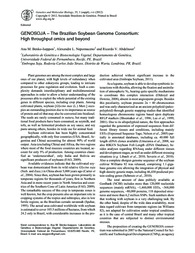GENOSOJA - The Brazilian Soybean Genome Consortium: high throughput omics and beyond.
GENOSOJA - The Brazilian Soybean Genome Consortium: high throughput omics and beyond.
Autoria: BENKO-ISEPPON, A. M.; NEPOMUCENO, A. L.; ABDELNOOR, R. V.
Resumo: Plant genomes are among the most complex and large ones of our planet, with high levels of redundancy when compared to other eukaryotic groups, leading to intricate processes for gene regulation and evolution. Such a complexity demands interdisciplinary and multidimensional approaches in order to allow a better understanding of the processes able to exploit the whole potential of the existing genes in different species, including crop plants. Among cultivated plants, soybean [Glycine max (L.) Merr.] occupies an outstanding position due to its importance as source of protein and oil that may also be converted into biodiesel. The seeds are rarely consumed in natura, but many traditional food products have been consumed, as soymilk, and tofu, as well as fermented products as soy sauce, and soy paste among others, besides its wide use for animal feed. Soybean cultivation has been highly concentrated geographically, with only four countries (USA, Brazil, Argentina and China) accounting for almost 90% of world output. Asia (excluding China) and Africa, the two regions where most of the food insecure countries are located, account for only 5% of production. Among countries classified as 'undernourished', only India and Bolivia are significant producers of soybeans (FAO, 2009). Available evidences indicate that the cultivated soybean was domesticated from its wild relative Glycine soja (Sieb. and Zucc.) in China about 5,000 years ago (Carter et al., 2004). Since then, soybean has been grown primarily in temperate regions for thousands of years, first in Northern Asia and in more recent years in North America and countries of the Southern Cone of Latin America (FAO, 2009). The remarkable success of this crop in temperate zones is well known, but the crop presents also an important role in cropping systems of the tropics and subtropics, also in low fertile regions, as the Brazilian cerrado savannah (Spehar, 1995). The actual area cultivated worldwide with soybean is estimated to cover 103.5 millions of hectares, from which 24.2 only in Brazil, with considerable increases in the production achieved without significant increase in the cultivated area (Embrapa Soybean, 2011). As a legume, soybean is able to develop symbiotic interactions with rhizobia, allowing the fixation and assimilation of atmospheric N2, bearing quite specific mechanisms to coordinate this complex interaction (Oldroyd and Downie, 2008), absent in most angiosperm groups. Besides this peculiarity, soybean presents 2n = 40 chromosomes and was early characterized as an ancient polyploid (paleopolyploid) through genetic mapping studies that identified homeologous chromosome regions based upon duplicate RFLP markers (Shoemaker et al., 1996; Lee et al., 1999; 2001). Due to its allopolyploid nature, the first approaches regarded the generation of expressed sequences from different library tissues and conditions, including mainly ESTs (Expressed Sequence Tags; Nelson et al., 2005) partially in annotated databases, including ca. 40.000 full length cDNA clones available (Umezawa et al., 2008, see also RIKEN Soybean Full-Length cDNA Database), besides analyses regarding RNAseq under different tissues and development stages, as well as under different stressing situations (e.g. Libault et al., 2010; Severin et al., 2010). Also a complete shotgun genome sequence of the soybean cultivar Williams 82 was released, comprising 1.1-gigabase genome size allowing the integration of physical and high-density genetic maps, including 46,430 predicted protein-coding genes (Schmutz et al., 2010). The total amount of data publicly available at GenBank (NCBI) includes more than 120,000 nucleotide sequences (mainly mRNA), ~1,460,000 ESTs, ~368,000 genome sequences, ~80,000 proteins, 118 deposited structures and more than 6,2 million SNPs. Such numbers show that working with soybean is a very challenging task. By the other hand, despite of the wide data availability, most data regard cultivars from temperate regions (as Williams 82), not adapted for cultivation under tropical conditions, as it is the case of central Brazil and many other tropical countries that are subjected to distinct environmental stresses. The proposition of creating the GENOSOJA consortium was submitted in 2007 to the National Council for Scientific and Technological Development (CNPq), an agency linked to the Brazilian Ministry of Science and Technology (MCT), starting its activity in March 2008 with the participation of nine Brazilian institutions from different regions (Figure 1). The proposal aimed to study the soybean genome from its organization into the structural level, seeking to characterize and sequence important genomic regions and their products, thus contributing to the identification of genes using transcriptional and proteomic methods, especially considering the plant response to different biotic and abiotic stresses that affect the culture in the Southern hemisphere. Still, the GENOSOJA net
Ano de publicação: 2012
Tipo de publicação: Artigo de periódico
Unidade: Embrapa Soja
Observações
1 - Por padrão são exibidas publicações dos últimos 20 anos. Para encontrar publicações mais antigas, configure o filtro ano de publicação, colocando o ano a partir do qual você deseja encontrar publicações. O filtro está na coluna da esquerda na busca acima.
2 - Para ler algumas publicações da Embrapa (apenas as que estão em formato ePub), é necessário ter, no celular ou computador, um desses softwares gratuitos. Sistemas Android: Google Play Livros; IOS: iBooks; Windows e Linux: software Calibre.
Acesse outras publicações
Acesse a Base de Dados da Pesquisa Agropecuária (BDPA) para consultar o acervo completo das bibliotecas da Embrapa.

